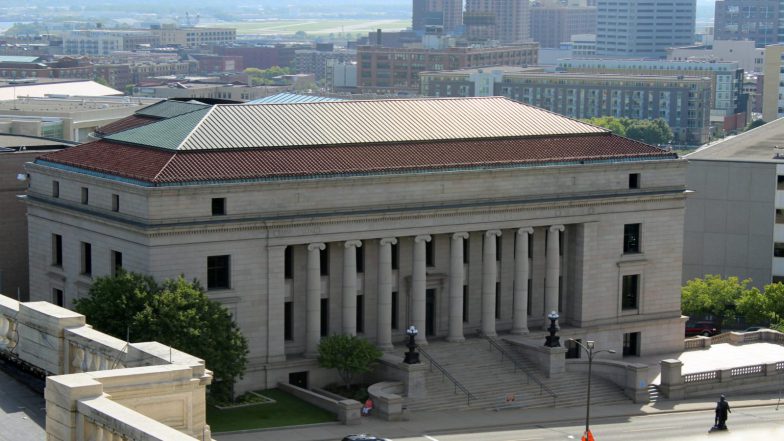Summary
The Minnesota Supreme Court is the highest court in the U.S. state of Minnesota. The court hears cases in the Supreme Court chamber in the Minnesota State Capitol or in the nearby Minnesota Judicial Center.
OnAir Post: MN Judicial Branch
Wikipedia
Contents
The Minnesota Supreme Court is the highest court in the U.S. state of Minnesota. The court hears cases in the Supreme Court chamber in the Minnesota State Capitol or in the nearby Minnesota Judicial Center.
History
The court was first assembled as a three-judge panel in 1849 when Minnesota was still a territory. The first members were lawyers from outside the region, appointed by President Zachary Taylor. The court system was rearranged when Minnesota became a state in 1858.
Appeals from Minnesota District Courts went directly to the Minnesota Supreme Court until the Minnesota Court of Appeals, an intermediate appellate court, was created in 1983 to handle most of those cases. The court now considers about 900 appeals per year and accepts review in about one in eight cases.[1] Before the Court of Appeals was created, the Minnesota Supreme Court handled about 1,800 cases a year. Certain appeals can go directly to the Supreme Court, such as those involving taxes, first degree murder, and workers' compensation.
Composition

The seven justices of the Minnesota Supreme Court are elected to renewable six-year terms.[2] When a midterm vacancy occurs, the governor of Minnesota appoints a replacement to a term that ends after the general election occurring more than one year after the appointment.[3] Most vacancies occur during a term. The most recent election to an open seat on the court was in 1992, when former Minnesota Vikings player Alan Page was elected. Judges in Minnesota have a mandatory retirement age of 70.[4][5]
In 1977, Rosalie E. Wahl became the first woman to serve on the Court.[6] In 1993, Alan Page became the first African American to serve on the Court.[7]
Anne McKeig, a descendant of the White Earth Band of Ojibwe, became the first Native American justice in 2016. Her appointment also marked the second time the court had a majority of women since 1991.[8]
In May 2020, Governor Tim Walz announced the appointment of Nobles County District Judge Gordon Moore, who replaced retiring Justice David Lillehaug.[9]
Salary
The salary for the Supreme Court Chief Justice is $205,362 and $186,692 for associate justices.[10]
Members
| Seat | Name[11] | Born | Start | Term Ends | Mandatory Retirement[a] | Appointer | Law School |
|---|---|---|---|---|---|---|---|
| Chief Justice | Natalie Hudson | January 13, 1957 | October 26, 2015[b] | January 6, 2031 | January 31, 2027 | Tim Walz (DFL)[c] | Minnesota |
| 5 | Anne McKeig | February 9, 1967 | August 31, 2016 | January 6, 2031 | February 28, 2037 | Mark Dayton (DFL) | Hamline |
| 4 | Paul Thissen | December 10, 1966 | May 14, 2018 | January 4, 2027 | December 31, 2036 | Mark Dayton (DFL) | Chicago |
| 3 | Gordon Moore | April 6, 1963 | August 3, 2020 | January 1, 2029 | April 30, 2033 | Tim Walz (DFL) | Iowa |
| 6 | Karl Procaccini | February 1, 1983 | October 2, 2023 | January 6, 2031 | February 28, 2053 | Tim Walz (DFL) | Harvard |
| 1 | Sarah Hennesy | 1969 or 1970 (age 55–56) | May 13, 2024 | January 4, 2027 | 2039 or 2040 | Tim Walz (DFL) | Drake |
| 2 | Theodora Gaïtas | 1970 or 1971 (age 54–55) | August 1, 2024 | January 4, 2027 | 2040 or 2041 | Tim Walz (DFL) | Minnesota |
- ^ Justices must retire at the end of the month in which they reach the age of 70.
- ^ Took office as Chief Justice on October 2, 2023 after being elevated by Governor Walz.
- ^ Originally appointed by Governor Mark Dayton (D) as Associate Justice. Subsequently appointed by Governor Tim Walz (D) as Chief Justice.
Notable cases
- Baker v. Nelson, 291 Minn. 310, 191 N.W.2d 185 (1971), in which the Court held that denial of the statutory entitlement demanded by gay citizens to marry the adult of one's choice does not offend the United States Constitution; overturned by Obergefell v. Hodges, 576 U.S. 644 (2015).
- Doe v. Gomez, 27 Minn. 542 N.W.2d 17 (1995), in which the Court held that the right of privacy under the Minnesota Constitution includes the right to an abortion and that the Minnesota government may not deny funding for abortion while funding other pregnancy-related medical services.
See also
References
- ^ "Supreme Court" (PDF). Minnesota Judicial Branch. Retrieved February 20, 2014.
- ^ "Minn. Const. art. VI, sec. 7". Minnesota Constitution. Office of the Revisor of Statutes. Retrieved February 20, 2014.
- ^ "Minn. Const. art. VI, sec. 8". Minnesota Constitution. Office of the Revisor of Statutes. Retrieved February 20, 2014.
- ^ "Minnesota Statutes 2013, section 490.121, subdivision 21d". Office of the Revisor of Statutes. Retrieved February 20, 2014.
- ^ "Minnesota Statutes 2013, section 490.121, subdivision 1". Office of the Revisor of Statutes. Retrieved February 20, 2014.
- ^ "Library Research Guides: Rosalie E. Wahl, Associate Justice 1977-1994: Biography".
- ^ "Alan C. Page".
- ^ Lopez, Ricardo (June 28, 2016). "Dayton selects McKeig as next Supreme Court justice". Star Tribune. Retrieved September 6, 2016.
- ^ Montemayor, Stephen (May 16, 2020). "Gov. Walz makes Worthington judge his first Minnesota Supreme Court selection". Star Tribune. Retrieved June 11, 2020.
- ^ "Minnesota Judicial Branch - How to Become a Judge". www.mncourts.gov. Retrieved March 29, 2021.
- ^ "Minnesota Supreme Court". Minnesota Judicial Branch.



